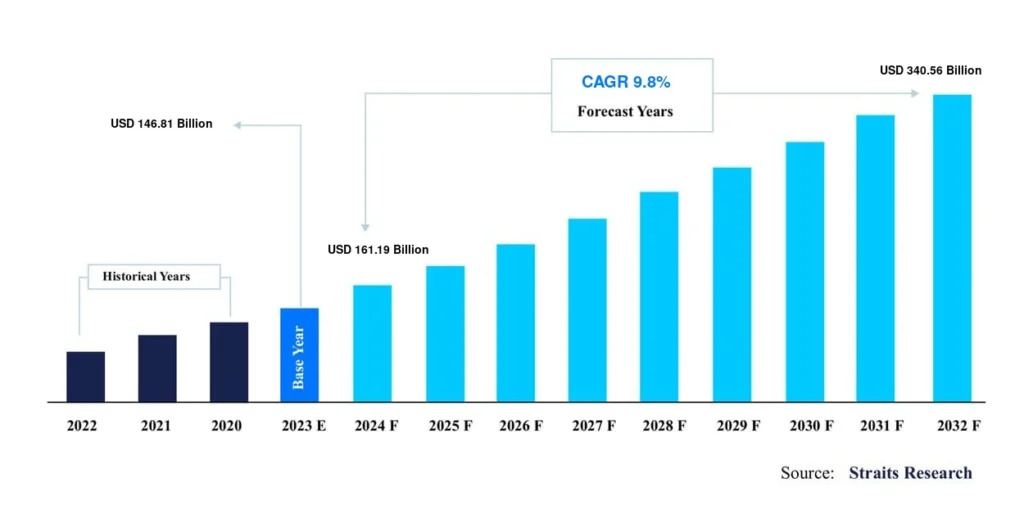
Table of Contents
The last-mile delivery sector is a dynamic and rapidly evolving component of the logistics and e-commerce landscape. As businesses strive to meet increasing consumer demands for quick and reliable deliveries, several key statistics highlight the current trends and future projections in the industry.
This article presents key statistics to shed light on the current state and future trends of last-mile delivery in 2024.
Top Last-Mile Delivery Market Statistics

Here are the top 10 last-mile delivery market statistics for 2024:
1. Market Size Growth
The global last-mile delivery market size was valued at USD 146.81 billion in 2023.
It is projected to reach USD 340.56 billion by 2032, registering a CAGR of 9.8% during the forecast period (2024-2032).
2. Consumer Expectations
Nearly 44% of consumers are willing to wait only two days for their orders, indicating a strong demand for faster delivery times.
Over 40% of American consumers prioritize fast and reliable delivery when shopping online.
3. Impact on Customer Satisfaction
Efficient last-mile delivery services are linked to improved customer satisfaction scores, with higher ratings for companies that meet delivery expectations.
Delays and inaccuracies in delivery significantly impact customer retention and brand loyalty.
4. Delivery Speed Preferences
Same-day delivery services dominate the market by delivery time segment, driven by consumer demand for immediate gratification.
The trend toward same-day and next-day delivery options continues to grow, with companies like Amazon and Walmart leading the charge.
5. Technological Advancements
Drones and autonomous vehicles hold significant market shares by technology, offering innovative solutions for efficient last-mile delivery.
The integration of AI and machine learning in route optimization and delivery management is enhancing operational efficiency.
6. E-Commerce Growth
E-commerce platforms lead the market by application, driven by the surge in online shopping and consumer reliance on digital retail.
The e-commerce segment is expected to continue its rapid growth, contributing significantly to the demand for last-mile delivery services.
7. Environmental Impact
The last mile of delivery is one of the most carbon-intensive phases of e-commerce fulfillment due to repeated stopping, idling, and traffic congestion.
There is a growing emphasis on sustainability, with companies exploring eco-friendly transportation options such as electric delivery trucks.
8. Regional Market Dominance
North America dominates the global last-mile delivery market with a well-developed e-commerce ecosystem and efficient logistics infrastructure.
Asia-Pacific is the fastest-growing market, driven by the booming e-commerce industry and innovative delivery solutions.
9. Challenges and Restraints
About 75% of customers report experiencing delivery issues, highlighting the risk of failed deliveries as a major challenge in last-mile logistics.
Addressing inefficiencies and maintaining a balance between cost-effectiveness and service quality remain critical concerns for businesses.
10. Market Opportunities
The demand for speedy deliveries is shaping the landscape of last-mile delivery services, with companies adapting to offer express delivery options.
Businesses that can provide quick and efficient delivery services without compromising on cost-effectiveness are well-positioned to succeed in the competitive market.
These statistics underscore the importance of innovation, efficiency, and customer-centric strategies in the last-mile delivery market. As the industry continues to evolve, staying abreast of these trends will be crucial for businesses aiming to enhance their delivery capabilities and meet the ever-growing demands of consumers.
Top Last-Mile Delivery Software Statistics in 2024

The last-mile delivery software market is undergoing significant transformation, driven by evolving consumer expectations, technological advancements, and the increasing prevalence of e-commerce.
As companies strive to optimize their logistics operations, last-mile delivery software is becoming a critical component of their strategy.
Here, we explore the key statistics and trends shaping the last-mile delivery software landscape in 2024.
1. Market Size and Growth
Market Size (2024E): USD 4.1 Billion
Projected Market Value (2032F): USD 7.4 Billion
Global Market Growth Rate (CAGR 2024 to 2032): 7.26%
The global last-mile delivery software market is expected to grow steadily over the next decade, with a compound annual growth rate (CAGR) of 7.26%. This growth is fueled by the increasing demand for efficient delivery solutions in various sectors, including e-commerce, retail, food delivery, and healthcare.
2. Market Dynamics
Drivers:
- E-commerce Boom: The exponential growth of e-commerce is a major driver for the last-mile delivery software market. Consumers increasingly expect faster and more reliable deliveries, pushing companies to adopt advanced logistics software.
- Technological Advancements: The integration of AI, IoT, and other advanced technologies in logistics operations enhances route planning, real-time tracking, and delivery analytics.
- Urbanization and Sustainability: The rise of urbanization and the need for sustainable delivery solutions further propel market expansion.
Restraints:
- Regulatory Complexities: Navigating regulatory hurdles can be challenging for companies, impacting the implementation of last-mile delivery software.
- High Initial Investment Costs: The cost of implementing advanced delivery software can be a barrier for some organizations.
- Logistical Challenges in Urban Environments: Dense urban areas present unique logistical challenges, such as traffic congestion and delivery access issues.
3. Key Market Segments

Deployment Types:
- On-Premise Solutions: On-premise last-mile delivery management software remains significant, but is slowly being outpaced by cloud solutions.
- Cloud-Based Solutions: While on-premise solutions currently lead, cloud-based software is gaining popularity due to its flexibility, ease of installation, and scalability.
Application Areas:
- E-commerce: E-commerce remains the largest application area, with significant investment in optimizing last-mile delivery to meet consumer demands.
- Food Delivery and Healthcare: These sectors are also seeing increased adoption of last-mile delivery software to enhance service efficiency and reliability.
4. Regional Insights

North America:
- Market Size (2032F): USD 6 Billion
- Growth Rate (2022 to 2032): 7.9% CAGR North America leads the market, driven by the strong e-commerce ecosystem and high consumer expectations for fast and reliable delivery services.
Asia-Pacific:
- Market Share (2024): 22.2%
- Forecasted Market Size (2032F): USD 3.7 Billion
- Growth Rate: 9.1% CAGR The Asia-Pacific region is emerging as a significant market, with increasing demand for advanced delivery solutions driven by the integration of online and offline retail.
5. Competitive Landscape
Leading companies focus on innovation and strategic partnerships to enhance their market presence. Investments in AI-driven delivery optimization algorithms, mobile-friendly interfaces, and scalable software solutions are key strategies for maintaining competitive advantage.
Check out the best last-mile delivery software in 2024.
6. Future Trends
Technological Innovations:
- Autonomous Delivery Vehicles: The adoption of autonomous vehicles for last-mile delivery is expected to transform logistics operations.
- Drone Deliveries: Drones are emerging as a viable solution for rapid and efficient last-mile delivery, particularly in hard-to-reach areas.
- Real-Time Mapping and Route Optimization: Advanced software capabilities enable real-time route planning, improving delivery efficiency and customer satisfaction.
- Predictive Analytics and Machine Learning: These technologies provide accurate ETAs and enhance the overall delivery experience.
7. Why Automate Last-Mile Delivery?
Efficiency and Cost Reduction: Automation helps reduce labor costs, optimize routes, and minimize delivery times.
Enhanced Customer Experience: Automated systems provide real-time updates, reducing the need for customer support and improving satisfaction.
Scalability: Advanced software solutions allow companies to scale their operations efficiently, adapting to increasing demand.
Conclusion
The last-mile delivery market is poised for significant growth, driven by technological advancements and the increasing demand for efficient delivery solutions. As companies continue to innovate and adopt new technologies, the market is expected to evolve rapidly, offering enhanced efficiency, customer satisfaction, and sustainability in last-mile logistics.
About Author
Shivangi Singh
Shivangi is a seasoned Technical Writer with a passion for simplifying technical concepts. With over 5 years of experience, she specializes in crafting clear and concise documentation for various technical products and platforms.









